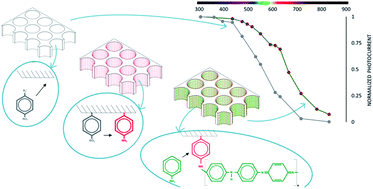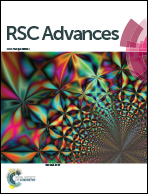Porous silicon–polyaniline hybrid composites synthesized through electroreduction of an aryldiazonium salt: preparation and photocurrent properties
Abstract
The results of an experimental study on the photocurrent properties of porous silicon (PSi) coated with polyaniline (PANI) are presented in this work. A three step approach is adopted for the fabrication of a stable and uniform coating: in the first step PSi electrodes were functionalized by electrochemical reduction of 4-nitrobenzenediazonium (NBD) salts in acetonitrile media, in the second step the nitro groups were electrochemically reduced to amino groups and in the last step aniline polymerization was performed on the surface of the aminophenyl-modified PSi. As a comparison, samples were prepared by direct polymerization of aniline onto PSi surfaces. The samples were characterized by reflectivity and photocurrent measurements. The results show an absorption capability of the NBD modified hybrid structures higher than those of the pristine PSi. The increase was in the range from 20% to 300%, depending on the wavelength. The photocurrent data are explained with the formation of a p–n junction between the polymer and semiconductor. The samples prepared by direct polymerization did not show appreciable variation with respect to the pristine PSi.



 Please wait while we load your content...
Please wait while we load your content...